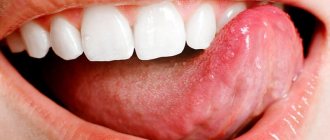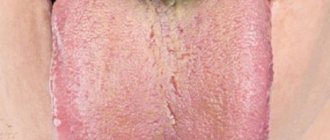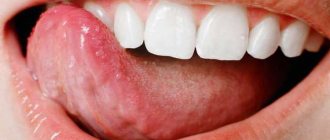Oral disease:
Aphthous stomatitis
- characterized by the appearance of point inflammations in the oral cavity, which are called aphthae.
These manifestations are quite painful and interfere with comfortable eating. Treatment of tongue ulcers lasts from one week to a month. As a rule, aphthous stomatitis leaves raised scars. Stomatitis
- inflammatory manifestations are covered with a gray-white film.
With daily rinsing it goes away within a week. Herpetic stomatitis
is expressed by the formation of small ulcers that are similar to herpetic manifestations on the lips.
The boundaries of inflammation are blurred and mainly affect the lower part of the tongue. They heal within 8-14 days, scars are not visible. Fungal stomatitis
(popularly called thrush) is most common in young children.
Easily treatable at home. Recurrent periadinitis
- first, compactions form on the submucosa, and then ulcers with raised edges appear.
Such manifestations are quite painful, form on the edges of the tongue, gums and lips, and take several months to heal. This type of ulcer on the tongue in adults and children can only be treated with the strict supervision of specialized specialists. Bernard's canker sores
- the most common ulcers on a child's tongue, manifests itself in the form of a plaque with a yellow tint. The reason is failure to maintain good oral hygiene. Treatment of ulcers is carried out within a week.
Gastritis (gastroduodenitis)
This is one of the most common gastrointestinal pathologies, often occurring in both adults and children. With gastritis, due to changes in secretion, the acidity of gastric juice increases, and since all organs of the digestive system are directly connected to each other, such acidity cannot but affect the health of the oral cavity.
Dental symptoms of this disease include pallor and swelling of the mucous membranes, hypertrophy of the tongue papillae, dry lips, gingivitis, bad breath and sour taste.
Chronic gastroduodenitis is characterized by mild forms of stomatitis and gingivitis.
, herpes on the lips.
In both cases, disturbances in the production of saliva occur, which most directly affects the acid-base balance of the oral cavity and the intensity of bacterial growth: with a lack of saliva, the risk of carious and periodontal diseases
.
Treatment:
as a rule, individual, aimed at normalizing gastric secretion, increasing the protective properties of the mucous membrane of the stomach and oral cavity.
Dental treatment may include taking a course of antibiotic drugs (as recommended by a doctor), treatment of gingivitis and caries
, enhanced
oral hygiene
using special toothpastes to strengthen the gums and
professional oral hygiene
performed at least once every six months.
Trauma to the oral mucosa.
- Incorrectly selected dentures or orthodontic devices.
- Injuries due to improper brushing of teeth.
- Injury to the tongue with sharp medical instruments.
- Irritation of the mucous membranes with acidic foods or concentrated medications.
- Chipping of damaged teeth causes trauma to the tongue.
The causes of ulcers on the tongue in an adult, caused by trauma, are not as problematic as diseases of the oral cavity, but the threat can be the penetration of viral infections through wounds and microcracks, which will lead to a more serious disease. Many people know how to treat ulcers on the tongue of this group - maintain strict oral hygiene during the initial injury. Solutions that have disinfecting abilities (chlorhexidine, chamomile decoction, calendula infusion) will cope best with this.
The tongue as a mirror of gastrointestinal health and other diseases
Many painful processes occurring in our body, one way or another, leave their “imprint” on the tongue. Go to the mirror and look at your tongue. Trembling of the tongue protruding from the mouth may indicate diseases of the nervous system, thyrotoxicosis (increased function of the thyroid gland), mercury poisoning or... alcoholism!) If your tongue is thickened, with teeth marks on the edges, covered with a white or yellowish coating, this indicates problems with the digestive system systems.
Plaque on the tongue appears due to poor chewing of food (lack of teeth, fast food), fever, diseases of the gastrointestinal tract, and exhaustion. Brown plaque often appears with infections of the gastrointestinal tract, for example, with dysentery.
It has long been noted that with gastritis with low acidity (hypoacid), the tongue is coated, and with high acidity (hyperacid gastritis, gastric ulcer), the back of the tongue is usually clean.
If it is also red, covered with cracks and ulcers, these are signs of inflammation of the tongue, glossitis. Normally, when the gastrointestinal tract is healthy, the tongue feels velvety because the back of the tongue is covered with taste buds.
With various diseases, the papillae can decrease in size, become less pronounced (atrophy), or, conversely, increase (hypertrophy). A smooth surface of the tongue, the so-called “polished” or “varnished” tongue, often appears with iron deficiency and B12 deficiency (pernicious) anemia, as well as with a deficiency of vitamins B2 and PP. The factors that lead to such changes in the mucous membrane of the tongue also affect the mucous membrane of the stomach and intestines: the same changes occur there - atrophy of the epithelium. Tongue with peptic ulcer of the stomach and duodenum, the papillae are also well expressed. The tongue can also be “folded” and “geographical”, when its surface is covered with folds or has areas of depression and elevation. These are also signs of a digestive system disease. Ulcers on the tongue can appear due to tuberculosis, syphilis, and oncological (tumor) diseases. The thought that it is worth contacting an oncologist for advice should arise if there are areas of thickened epithelium on the tongue. People infected with HIV may develop lingual hairy leukoplakia (“hairy tongue”)—the root of the tongue (the place where the tongue attaches to the mouth) becomes covered in long, thin growths that look like hair.
There are contraindications. Read the instructions or consult a specialist.
Ulcers on the tongue are caused by common diseases.
Ulcers are caused by viral diseases, stomatitis, deterioration of the immune system, and exhaustion of the body. In this case, ulcers under the tongue, active salivation, unstable temperature, sweating, and bad breath are characteristic. The inflammations are covered with a greenish coating with jagged edges. Ulcers caused by pulmonary tuberculosis. As a rule, it provokes oral tuberculosis. This disease is characterized by loose ulcers with raised edges. Vivid symptoms of oral tuberculosis will be fever, lethargy, and mild nausea. Mouth ulcers are caused by an infectious disease such as syphilis. Inflammation accompanies the entire cavity - tongue, lips, palate, throughout the entire period of the disease, except for the incubation period. Ulcers on the tongue are not accompanied by severe pain, but heal in 2 to 4 months and leave pronounced scars.
Ulcers on the tongue, lips, cheeks, gums, palate due to HIV disease.
These manifestations are inevitable with such a diagnosis, although with careful monitoring and drug support they are treatable. Oral ulcers of the last group are the most risky category of diseases that are provoked by serious illnesses. Recovery is possible through systemic treatment and constant monitoring of both medical workers and the patient himself. This article is for informational purposes only, please consult your doctor for details!
general description
Peptic ulcer of the stomach and duodenum is a chronic seasonal recurrent disease of the stomach and duodenum, manifested by a defect in the mucous membrane (ulcers).
These disorders occur against the background of destabilization of the nervous and humoral mechanisms in the human body, which regulate secretory-reparative processes in the stomach and duodenum. Peptic ulcer disease is characterized by periods of exacerbation (spring and autumn) and remission. The result of ulcer healing is the formation of a scar. The prevalence of the disease in all countries is about 4-6% of the adult population. With full medical screening of patients, this percentage increases to 20-25%.
The peak incidence occurs at the age of 30-45 years. Mostly in men aged 35-50 years, peptic ulcer of the stomach and duodenum is 3-4 times more common.
Methods for diagnosing stomach ulcers
In the diagnosis of gastric ulcers, instrumental diagnostics and laboratory methods are used. The main importance is attached to the endoscopic method - EGDS (gastroscopy).
Gastroscopy
Gastroscopy allows you to identify ulceration, clarify its location, size and depth, and determine whether bleeding is occurring. Gastroscopy also makes it possible to evaluate the relief and elasticity of the mucosa.
More information about the diagnostic method
X-ray
For stomach ulcers, a diagnostic method such as fluoroscopy can be used. Fluoroscopy is a real-time X-ray examination. The patient's stomach is filled with a contrast agent. Using X-rays, an image of the contours of the stomach is obtained. You can evaluate the dynamics of the passage of the contrast agent. In case of a gastric ulcer, examination reveals “niches” - a persistent accumulation of contrast agent on the relief of the mucous membrane or on the contour of the organ wall.
General blood analysis
With a peptic ulcer, you should expect that a general blood test will show an increase in the number of red blood cells, an increase in hemoglobin and a slowdown in ESR.
More information about the diagnostic method
Fecal occult blood test
The standard of examination for suspected gastric ulcers usually includes a stool occult blood test.
Detection of Helicobacter pylori
The cause of the inflammatory process in the stomach may be the bacterium Helicobacter pylori. In order for the treatment to be effective, it is necessary to establish its presence in the patient’s stomach. For this purpose the following may be carried out:
- taking a biopsy of the gastric mucosa during endoscopy for subsequent microscopic or cultural examination;
- urease breath test;
- stool analysis for detection of Helicobacter pylori antigen;
- serological blood test;
- PCR diagnostics.
Sign up for diagnostics To accurately diagnose the disease, make an appointment with specialists from the Family Doctor network.
Diagnostics
- General clinical analysis of blood and urine
- Analysis of stool for coprogram
- Fecal occult blood test
- Biochemical blood test (liver tests, cholesterol, alkaline phosphatase)
- ECG
- X-ray of the chest organs in 2 projections and X-ray of the abdominal organs (to exclude perforation of ulcers)
- X-ray of the esophagus, stomach with barium mixture
- Ultrasound of the hepatobiliary system
- 24-hour pH monitoring in the lower esophagus and stomach
- EGDS
- Non-invasive tests for the determination of Helicobacter pylori (respiratory)
Symptoms of a stomach ulcer
The most common complaint characterizing the presence of a peptic ulcer in a patient is pain in the stomach.
Abdominal pain
The pain of a stomach ulcer is in most cases sharp, burning, aching. However, the pain can also be vague, dull or felt like a feeling of fullness in the stomach (heaviness in the abdomen), sometimes reminiscent of hunger. In people suffering from duodenal ulcers, abdominal pain occurs 1.5-3 hours after eating. Night attacks of pain often occur.
Symptoms of peptic ulcer of the stomach and duodenum
- Aching or cramping pain, low intensity in the epigastric region, often occurs on an empty stomach or immediately after eating
- Constant heartburn, especially at night and in the morning, sour belching
- Nausea
- Belching with air, sour or bitter taste
- Heaviness in the epigastric region after eating, a feeling of rapid filling of the stomach
- Decreased appetite
- When bleeding from ulcers, vomiting appears like “coffee grounds”, dark stools (melena)
- With perforation of ulcers - severe, dagger-like pain in the epigastric region, nausea, vomiting, painful tension in the abdominal muscles
Treatment methods for stomach ulcers
The course of treatment for peptic ulcer disease is selected strictly individually and includes a whole range of drugs aimed at combating Helicobacter pylori, reducing the secretion and acidity of gastric juice.
As soon as a person suspects an ulcer, he should immediately seek advice from a gastroenterologist. You can contact any of the clinics of JSC “Family Doctor”. Our doctors will prescribe the necessary examinations and treat gastric and duodenal ulcers in accordance with the latest international standards.
Make an appointment Do not self-medicate. Contact our specialists who will correctly diagnose and prescribe treatment.
Rate how useful the material was
thank you for rating
Causes of peptic ulcer
- The presence of Helicobacter pylori in the stomach and duodenum, which is the main etiological factor in the occurrence of ulcers. The influence of other bacteria has not been proven
- Eating disorder
- Alcohol and tobacco abuse
- Long-term use of drugs that affect the gastric mucosa, the main ones: NSAIDs and glucocorticosteroids (prednisolone)
- Emotional overstrain, stress
- Genetic predisposition
- Metabolic disorders
- Hypovitaminosis
Causes of stomach ulcers
Most often, peptic ulcer disease is associated with an imbalance between aggressive and protective factors affecting the mucous membrane of the stomach or duodenum. Aggressive factors include hydrochloric acid, which is part of the gastric juice, liver bile acids, which enter the duodenum, as well as the reflux of the contents of the duodenum into the stomach. Protective factors are mucus secreted by the gastric mucosa, normal blood circulation, timely restoration and renewal of mucosal cells.










